The Cambridge History of China. Vol. 12: Republican China, 1912-1949, Part 1
Подождите немного. Документ загружается.

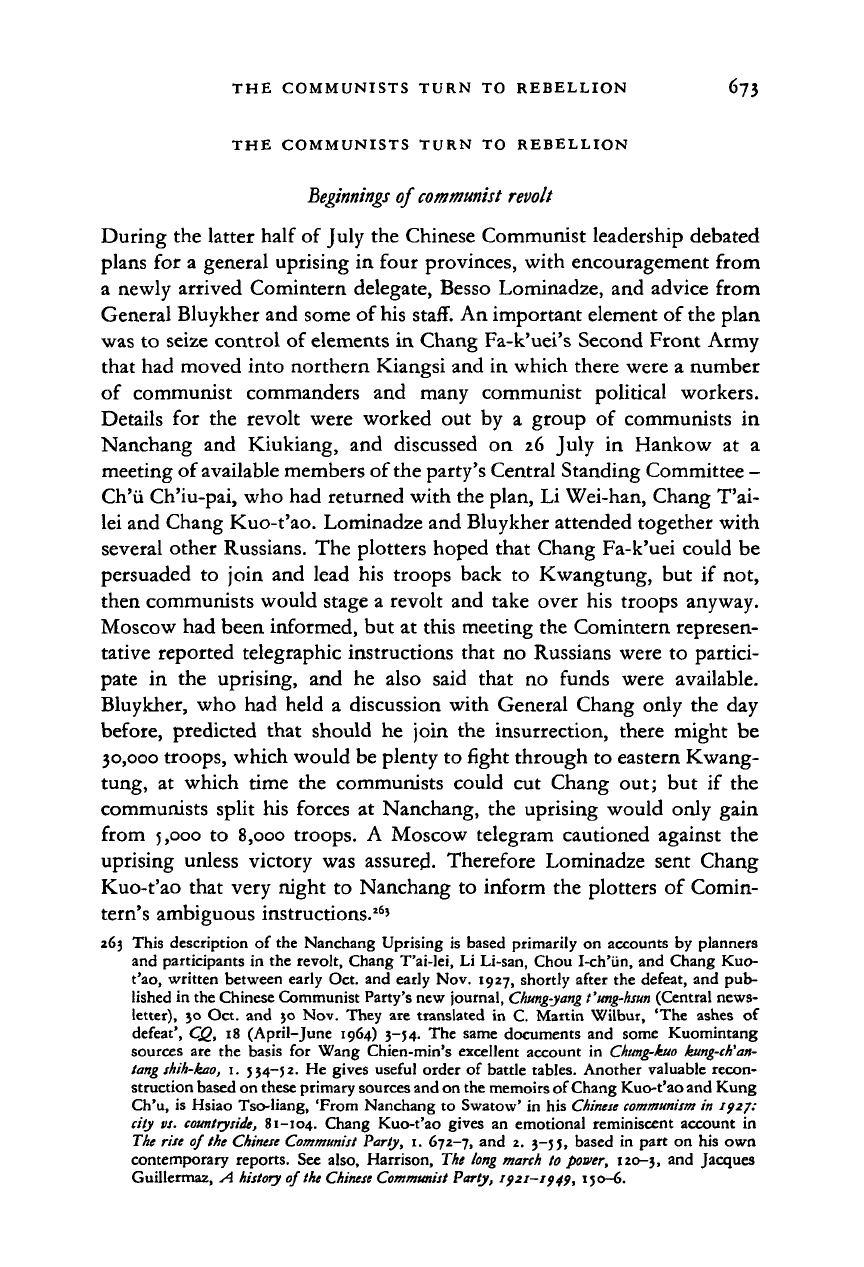
THE COMMUNISTS TURN TO REBELLION 673
THE COMMUNISTS TURN TO REBELLION
Beginnings of communist revolt
During the latter half of July the Chinese Communist leadership debated
plans for a general uprising in four provinces, with encouragement from
a newly arrived Comintern delegate, Besso Lominad2e, and advice from
General Bluykher and some of his
staff.
An important element of the plan
was to seize control of elements in Chang Fa-k'uei's Second Front Army
that had moved into northern Kiangsi and in which there were a number
of communist commanders and many communist political workers.
Details for the revolt were worked out by a group of communists in
Nanchang and Kiukiang, and discussed on 26 July in Hankow at a
meeting of available members of the party's Central Standing Committee -
Ch'ii Ch'iu-pai, who had returned with the plan, Li Wei-han, Chang T'ai-
lei and Chang Kuo-t'ao. Lominadze and Bluykher attended together with
several other Russians. The plotters hoped that Chang Fa-k'uei could be
persuaded to join and lead his troops back to Kwangtung, but if not,
then communists would stage a revolt and take over his troops anyway.
Moscow had been informed, but at this meeting the Comintern represen-
tative reported telegraphic instructions that no Russians were to partici-
pate in the uprising, and he also said that no funds were available.
Bluykher, who had held a discussion with General Chang only the day
before, predicted that should he join the insurrection, there might be
30,000 troops, which would be plenty to fight through to eastern Kwang-
tung, at which time the communists could cut Chang out; but if the
communists split his forces at Nanchang, the uprising would only gain
from
5,000
to
8,000
troops. A Moscow telegram cautioned against the
uprising unless victory was assured. Therefore Lominadze sent Chang
Kuo-t'ao that very night to Nanchang to inform the plotters of Comin-
tern's ambiguous instructions.
26
'
263 This description of the Nanchang Uprising is based primarily on accounts by planners
and participants in the revolt, Chang T'ai-lei, Li Li-san, Chou I-ch'iin, and Chang Kuo-
t'ao, written between early Oct. and early Nov. 1927, shortly after the defeat, and pub-
lished in the Chinese Communist Party's new journal,
Chung-yang
t'ung-hsun
(Central news-
letter),
30 Oct. and 30 Nov. They are translated in C. Martin Wilbur, 'The ashes of
defeat', CQ, 18 (April-June 1964) 3-54. The same documents and some Kuomintang
sources are the basis for Wang Chien-min's excellent account in
Chtmg-kuo
kung-ch'an-
tang
shih-kao,
1. 534-52. He gives useful order of battle tables. Another valuable recon-
struction based on these primary sources and on the memoirs of Chang Kuo-t'ao and Kung
Ch'u,
is Hsiao Tso-liang, 'From Nanchang to Swatow' in his
Chinese communism
in 1927:
city vs.
countryside,
81-104. Chang Kuo-t'ao gives an emotional reminiscent account in
The rise of the
Chinese Communist
Party, 1. 672-7, and 2. 3-55, based in part on his own
contemporary reports. See also, Harrison, The
long
march to power, 120-3,
an
^ Jacques
Guillermaz, A
history
of
the Chinese Communist
Party, 1921-1949, 150-6.
Cambridge Histories Online © Cambridge University Press, 2008
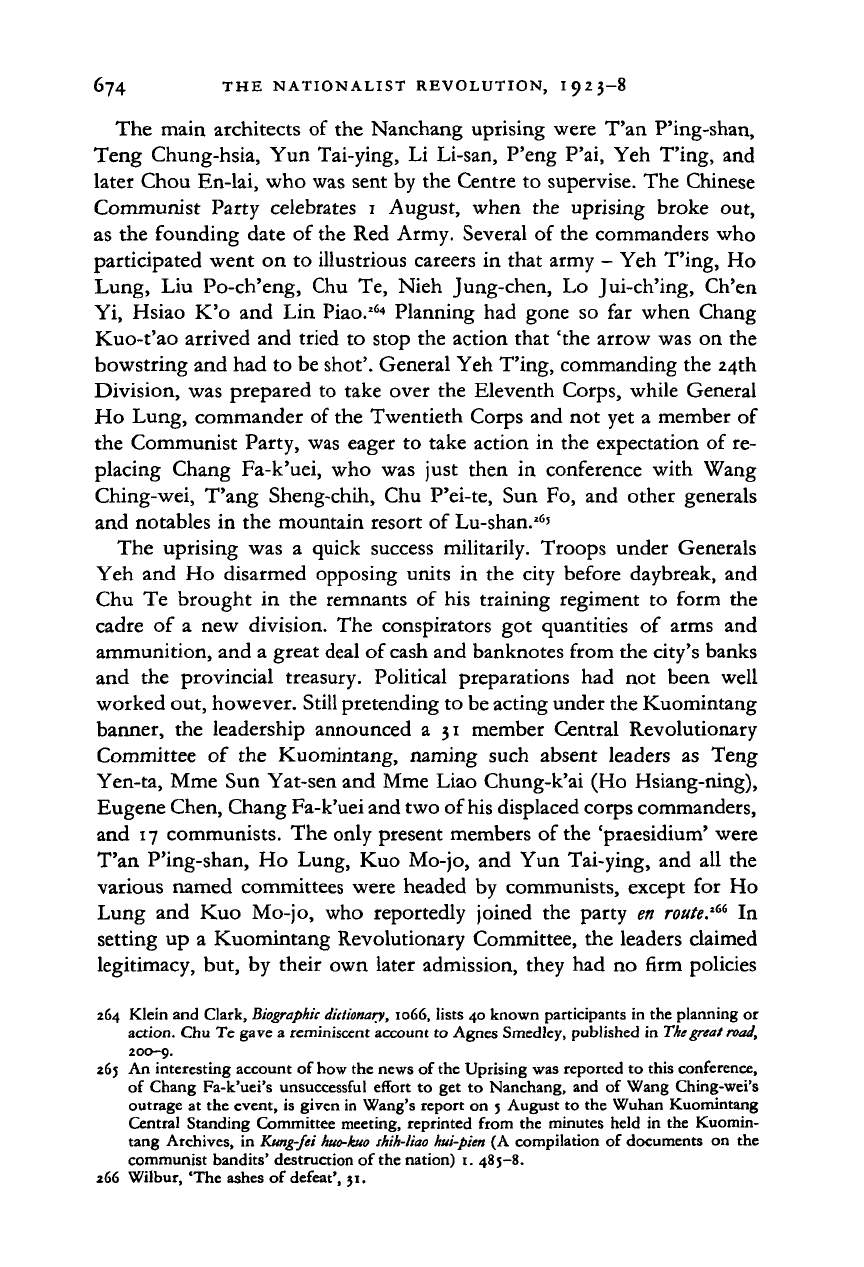
674
THE
NATIONALIST REVOLUTION, I923-8
The main architects
of
the Nanchang uprising were T'an P'ing-shan,
Teng Chung-hsia, Yun Tai-ying,
Li
Li-san, P'eng P'ai, Yeh T'ing, and
later Chou En-lai, who was sent by the Centre to supervise. The Chinese
Communist Party celebrates
i
August, when
the
uprising broke
out,
as the founding date of the Red Army. Several
of
the commanders who
participated went on
to
illustrious careers
in
that army
-
Yeh T'ing,
Ho
Lung,
Liu
Po-ch'eng, Chu Te, Nieh Jung-chen,
Lo
Jui-ch'ing, Ch'en
Yi,
Hsiao
K'o and
Lin Piao.
264
Planning had gone
so far
when Chang
Kuo-t'ao arrived and tried
to
stop the action that 'the arrow was on the
bowstring and had to be shot'. General Yeh T'ing, commanding the 24th
Division, was prepared
to
take over the Eleventh Corps, while General
Ho Lung, commander of the Twentieth Corps and not yet
a
member of
the Communist Party, was eager
to
take action
in
the expectation
of
re-
placing Chang Fa-k'uei, who was just then
in
conference with Wang
Ching-wei, T'ang Sheng-chih, Chu P'ei-te, Sun Fo,
and
other generals
and notables
in
the mountain resort
of
Lu-shan.
26
'
The uprising was
a
quick success militarily. Troops under Generals
Yeh and
Ho
disarmed opposing units
in
the city before daybreak, and
Chu
Te
brought
in the
remnants
of
his training regiment
to
form
the
cadre
of a
new division. The conspirators
got
quantities
of
arms
and
ammunition, and
a
great deal of cash and banknotes from the city's banks
and
the
provincial treasury. Political preparations
had not
been well
worked out, however. Still pretending to be acting under the Kuomintang
banner,
the
leadership announced
a
31 member Central Revolutionary
Committee
of the
Kuomintang, naming such absent leaders
as
Teng
Yen-ta, Mme Sun Yat-sen and Mme Liao Chung-k'ai (Ho Hsiang-ning),
Eugene Chen, Chang Fa-k'uei and two of his displaced corps commanders,
and 17 communists. The only present members of the 'praesidium' were
T'an P'ing-shan,
Ho
Lung, Kuo Mo-jo, and Yun Tai-ying, and all the
various named committees were headed
by
communists, except
for Ho
Lung
and
Kuo Mo-jo, who reportedly joined
the
party en route.*
6
In
setting up
a
Kuomintang Revolutionary Committee, the leaders claimed
legitimacy, but,
by
their own later admission, they had
no
firm policies
264 Klein and Clark,
Biographic
dictionary,
1066, lists 40 known participants in the planning or
action. Chu Te gave
a
reminiscent account to Agnes Smedley, published in The great
road,
200-9.
265 An interesting account
of
how the news
of
the Uprising was reported to this conference,
of Chang Fa-k'uei's unsuccessful effort
to get to
Nanchang, and
of
Wang Ching-wei's
outrage
at
the event,
is
given in Wang's report on 5 August
to
the Wuhan Kuomintang
Central Standing Committee meeting, reprinted from the minutes held
in
the Kuomin-
tang Archives,
in
Ktmg-fei
huo-kuo shih-liao hui-pien
(A
compilation
of
documents
on the
communist bandits' destruction
of
the nation)
1.
485-8.
266 Wilbur, "The ashes
of
defeat', 31.
Cambridge Histories Online © Cambridge University Press, 2008
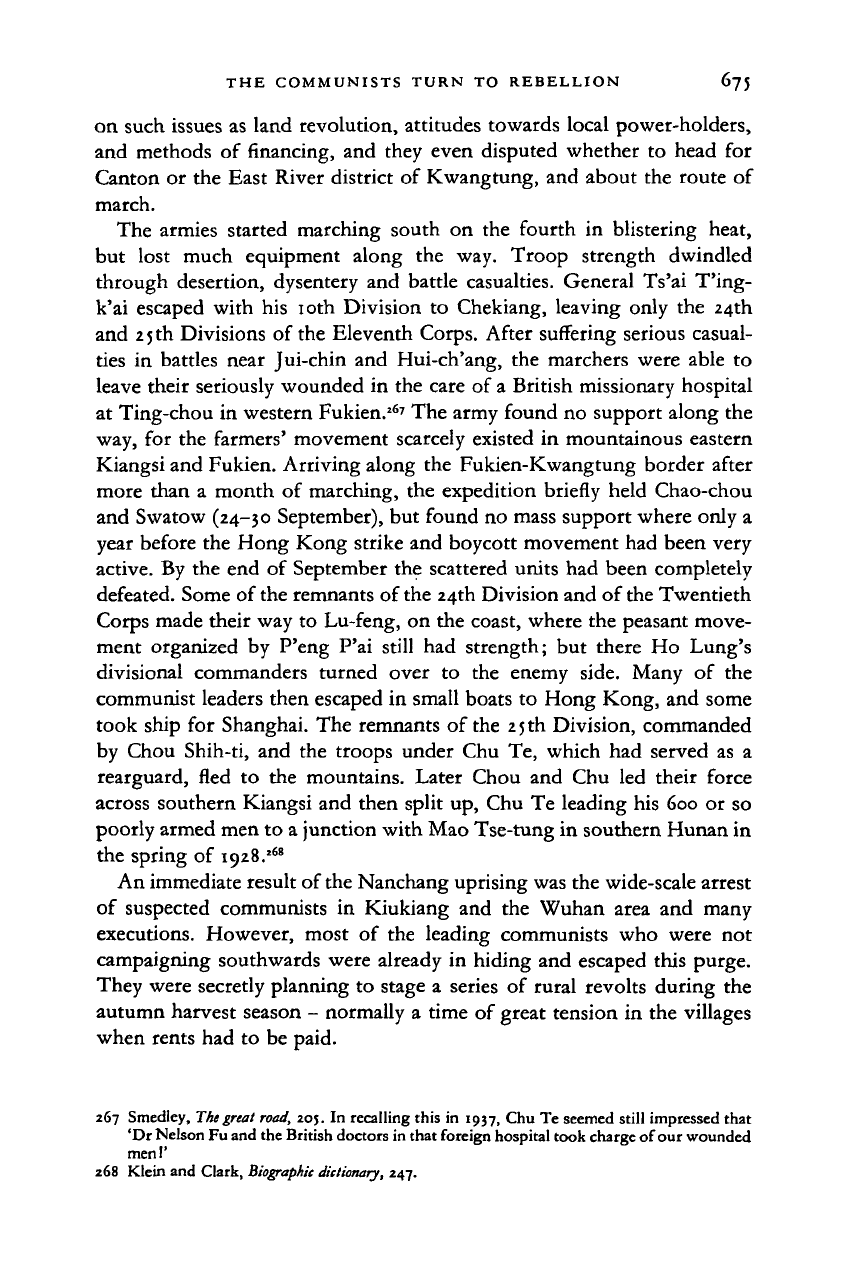
THE COMMUNISTS TURN TO REBELLION 675
on such issues as land revolution, attitudes towards local power-holders,
and methods of financing, and they even disputed whether to head for
Canton or the East River district of Kwangtung, and about the route of
march.
The armies started marching south on the fourth in blistering heat,
but lost much equipment along the way. Troop strength dwindled
through desertion, dysentery and battle casualties. General Ts'ai T'ing-
k'ai escaped with his ioth Division to Chekiang, leaving only the 24th
and
25
th Divisions of the Eleventh Corps. After suffering serious casual-
ties in battles near Jui-chin and Hui-ch'ang, the marchers were able to
leave their seriously wounded in the care of a British missionary hospital
at Ting-chou in western Fukien.
267
The army found no support along the
way, for the farmers' movement scarcely existed in mountainous eastern
Kiangsi and Fukien. Arriving along the Fukien-Kwangtung border after
more than a month of marching, the expedition briefly held Chao-chou
and Swatow (24-30 September), but found no mass support where only a
year before the Hong Kong strike and boycott movement had been very
active. By the end of September the scattered units had been completely
defeated. Some of the remnants of the 24th Division and of the Twentieth
Corps made their way to Lu-feng, on the coast, where the peasant move-
ment organized by P'eng P'ai still had strength; but there Ho Lung's
divisional commanders turned over to the enemy side. Many of the
communist leaders then escaped in small boats to Hong Kong, and some
took ship for Shanghai. The remnants of the 25 th Division, commanded
by Chou Shih-ti, and the troops under Chu Te, which had served as a
rearguard, fled to the mountains. Later Chou and Chu led their force
across southern Kiangsi and then split up, Chu Te leading his 600 or so
poorly armed men to a junction with Mao Tse-tung in southern Hunan in
the spring of 1928.
268
An immediate result of the Nanchang uprising was the wide-scale arrest
of suspected communists in Kiukiang and the Wuhan area and many
executions. However, most of the leading communists who were not
campaigning southwards were already in hiding and escaped this purge.
They were secretly planning to stage a series of rural revolts during the
autumn harvest season - normally a time of great tension in the villages
when rents had to be paid.
267 Smedley,
The great
road,
205. In recalling this in 1937, Chu Te seemed still impressed that
'Dr Nelson Fu and the British doctors in that foreign hospital took charge of our wounded
men I'
268
Klein
and
Clark,
Biographic
dictionary,
247.
Cambridge Histories Online © Cambridge University Press, 2008
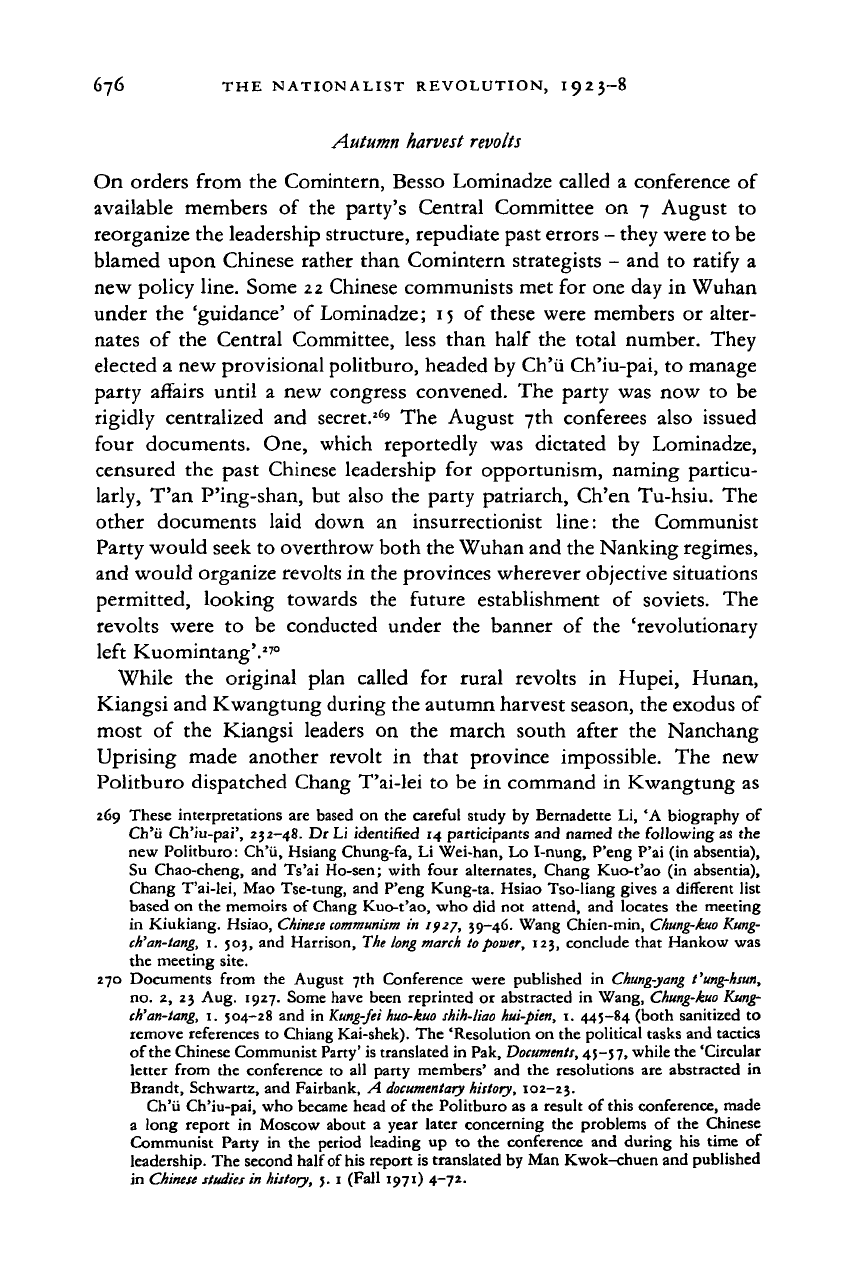
676 THE NATIONALIST REVOLUTION, I 9
2
3-8
Autumn harvest revolts
On orders from
the
Comintern, Besso Lominadze called
a
conference
of
available members
of
the
party's Central Committee
on 7
August
to
reorganize
the
leadership structure, repudiate past errors
-
they were
to be
blamed upon Chinese rather than Comintern strategists
-
and
to
ratify
a
new policy line. Some 22 Chinese communists
met for one day in
Wuhan
under
the
'guidance'
of
Lominadze;
15
of
these were members
or
alter-
nates
of
the
Central Committee, less than half
the
total number. They
elected
a new
provisional politburo, headed
by
Ch'ti Ch'iu-pai,
to
manage
party affairs until
a
new
congress convened.
The
party
was now
to be
rigidly centralized
and
secret.
2
''
The
August
7th
conferees also issued
four documents.
One,
which reportedly
was
dictated
by
Lominadze,
censured
the
past Chinese leadership
for
opportunism, naming particu-
larly,
T'an
P'ing-shan,
but
also
the
party patriarch, Ch'en Tu-hsiu.
The
other documents laid down
an
insurrectionist line:
the
Communist
Party would seek
to
overthrow both
the
Wuhan
and the
Nanking regimes,
and would organize revolts
in
the provinces wherever objective situations
permitted, looking towards
the
future establishment
of
Soviets.
The
revolts were
to be
conducted under
the
banner
of
the
'revolutionary
left Kuomintang'.
270
While
the
original plan called
for
rural revolts
in
Hupei, Hunan,
Kiangsi
and
Kwangtung during
the
autumn harvest season,
the
exodus
of
most
of
the
Kiangsi leaders
on the
march south after
the
Nanchang
Uprising made another revolt
in
that province impossible.
The new
Politburo dispatched Chang T'ai-lei
to be in
command
in
Kwangtung
as
269 These interpretations
are
based
on the
careful study
by
Bernadette
Li, 'A
biography
of
Ch'ii Ch'iu-pai', 2J2-48.
Dr
Li identified 14 participants and named the following as
the
new Politburo: Ch'ii, Hsiang Chung-fa,
Li
Wei-han,
Lo
I-nung, P'eng P'ai
(in
absentia),
Su Chao-cheng,
and
Ts'ai Ho-sen; with four alternates, Chang Kuo-t'ao
(in
absentia),
Chang T'ai-lei, Mao Tse-tung,
and
P'eng Kung-ta. Hsiao Tso-liang gives
a
different list
based
on the
memoirs
of
Chang Kuo-t'ao, who did
not
attend,
and
locates
the
meeting
in Kiukiang. Hsiao,
Chinese communism
in
if 27, 39—46. Wang Chien-min,
Chung-kuo
Kung-
ch'an-tang,
1.
503,
and
Harrison, The
long march to
power,
123, conclude that Hankow was
the meeting site.
270 Documents from
the
August
7th
Conference were published
in
Chung-yang
t'ung-hsun,
no.
2, 2}
Aug. 1927. Some have been reprinted
or
abstracted
in
Wang,
Chung-kuo
Kung-
ch'an-tang,
1.
504-28
and in
Kung-fei
huo-kuo shih-liao hui-pien,
1.
445—84 (both sanitized
to
remove references
to
Chiang Kai-shek). The 'Resolution
on
the political tasks and tactics
of the Chinese Communist Party' is translated in Pak,
Documents,
45-57, while the 'Circular
letter from
the
conference
to all
party members'
and the
resolutions
are
abstracted
in
Brandt, Schwartz, and Fairbank,
A
documentary
history,
102-25.
Ch'ii Ch'iu-pai, who became head
of
the Politburo as
a
result
of
this conference, made
a long report
in
Moscow about
a
year later concerning
the
problems
of the
Chinese
Communist Party
in the
period leading
up to the
conference
and
during
his
time
of
leadership. The second half of his report is translated by Man Kwok-chuen and published
in
Chinese
studies
in
history,
5. 1
(Fall 1971)
4-72.
Cambridge Histories Online © Cambridge University Press, 2008
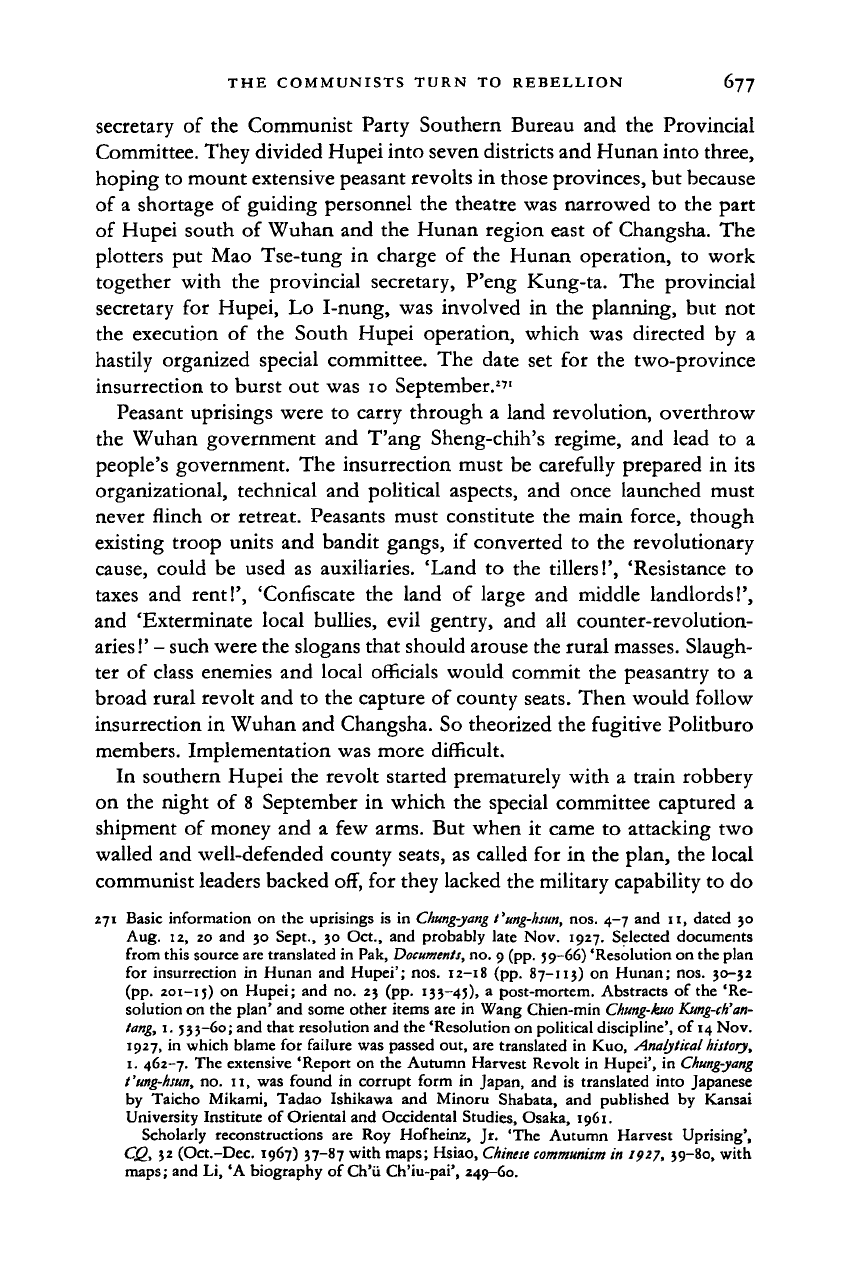
THE COMMUNISTS TURN TO REBELLION 677
secretary of the Communist Party Southern Bureau and the Provincial
Committee. They divided Hupei into seven districts and Hunan into three,
hoping to mount extensive peasant revolts in those provinces, but because
of a shortage of guiding personnel the theatre was narrowed to the part
of Hupei south of Wuhan and the Hunan region east of Changsha. The
plotters put Mao Tse-tung in charge of the Hunan operation, to work
together with the provincial secretary, P'eng Kung-ta. The provincial
secretary for Hupei, Lo I-nung, was involved in the planning, but not
the execution of the South Hupei operation, which was directed by a
hastily organized special committee. The date set for the two-province
insurrection to burst out was 10 September.
2
'
1
Peasant uprisings were to carry through a land revolution, overthrow
the Wuhan government and T'ang Sheng-chih's regime, and lead to a
people's government. The insurrection must be carefully prepared in its
organizational, technical and political aspects, and once launched must
never flinch or retreat. Peasants must constitute the main force, though
existing troop units and bandit gangs, if converted to the revolutionary
cause, could be used as auxiliaries. 'Land to the tillers!', 'Resistance to
taxes and rent!', 'Confiscate the land of large and middle landlords!',
and 'Exterminate local bullies, evil gentry, and all counter-revolution-
aries
!'
- such were the slogans that should arouse the rural masses. Slaugh-
ter of class enemies and local officials would commit the peasantry to a
broad rural revolt and to the capture of county seats. Then would follow
insurrection in Wuhan and Changsha. So theorized the fugitive Politburo
members. Implementation was more difficult.
In southern Hupei the revolt started prematurely with a train robbery
on the night of 8 September in which the special committee captured a
shipment of money and a few arms. But when it came to attacking two
walled and well-defended county seats, as called for in the plan, the local
communist leaders backed off, for they lacked the military capability to do
271 Basic information on the uprisings is in
Chung-yang
t'img-hsun,
nos. 4-7 and 11, dated 30
Aug. 12, 20 and 30 Sept., 30 Oct., and probably late Nov. 1927. Selected documents
from this source are translated in Pak,
Documents,
no. 9 (pp. 5 9-66) 'Resolution on the plan
for insurrection in Hunan and Hupei'; nos. 12-18 (pp. 87-113) on Hunan; nos. 30-32
(pp.
201-15)
on
Hupei; and no. 23 (pp. 133-45), a post-mortem. Abstracts of the 'Re-
solution on the plan' and some other items are in Wang Chien-min
Chung-kuo
Kung-ch'an-
tang,
1. 533-60; and that resolution and the 'Resolution on political discipline', of
14
Nov.
1927,
in which blame for failure was passed out, are translated in Kuo,
Analytical
history,
1.
462-7. The extensive 'Report on the Autumn Harvest Revolt in Hupei', in
Chung-yang
t'ung-hsun,
no. 11, was found in corrupt form in Japan, and is translated into Japanese
by Taicho Mikami, Tadao Ishikawa and Minoru Shabata, and published by Kansai
University Institute of Oriental and Occidental Studies, Osaka, 1961.
Scholarly reconstructions are Roy Hofheinz, Jr. "The Autumn Harvest Uprising',
Q2.
5
2
(Oct.-Dec. 1967) 37-87 with maps; Hsiao,
Chinese communism
in
1927,
39-80, with
maps;
and Li, 'A biography of Ch'tt Ch'iu-pai', 249-60.
Cambridge Histories Online © Cambridge University Press, 2008
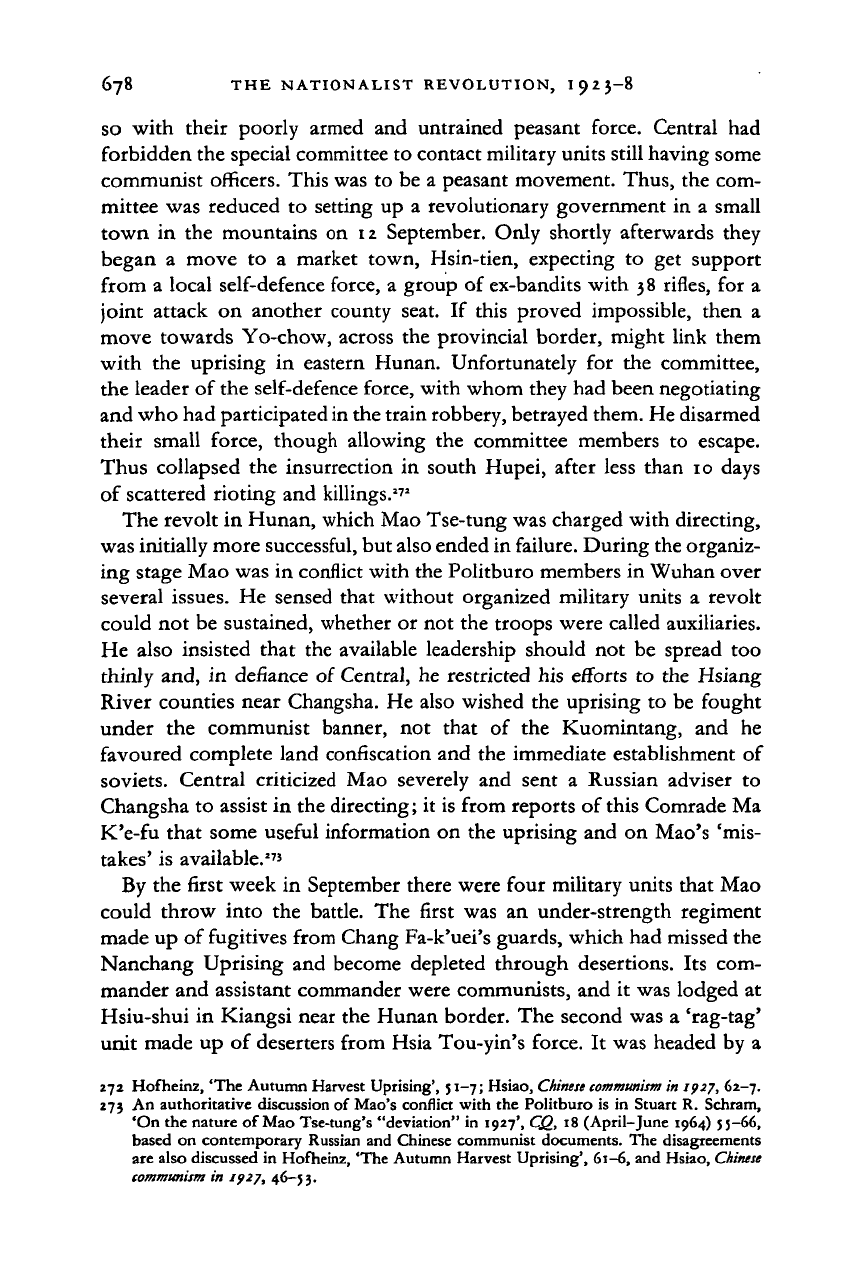
678 THE NATIONALIST REVOLUTION, I 9 2 3-8
so with their poorly armed and untrained peasant force. Central had
forbidden the special committee to contact military units still having some
communist officers. This was to be a peasant movement. Thus, the com-
mittee was reduced to setting up a revolutionary government in a small
town in the mountains on 12 September. Only shortly afterwards they
began a move to a market town, Hsin-tien, expecting to get support
from a local self-defence force, a group of ex-bandits with 38 rifles, for a
joint attack on another county seat. If this proved impossible, then a
move towards Yo-chow, across the provincial border, might link them
with the uprising in eastern Hunan. Unfortunately for the committee,
the leader of the self-defence force, with whom they had been negotiating
and who had participated in the train robbery, betrayed them. He disarmed
their small force, though allowing the committee members to escape.
Thus collapsed the insurrection in south Hupei, after less than 10 days
of scattered rioting and killings.
272
The revolt in Hunan, which Mao Tse-tung was charged with directing,
was initially more successful, but also ended in failure. During the organiz-
ing stage Mao was in conflict with the Politburo members in Wuhan over
several issues. He sensed that without organized military units a revolt
could not be sustained, whether or not the troops were called auxiliaries.
He also insisted that the available leadership should not be spread too
thinly and, in defiance of Central, he restricted his efforts to the Hsiang
River counties near Changsha. He also wished the uprising to be fought
under the communist banner, not that of the Kuomintang, and he
favoured complete land confiscation and the immediate establishment of
Soviets. Central criticized Mao severely and sent a Russian adviser to
Changsha to assist in the directing; it is from reports of this Comrade Ma
K'e-fu that some useful information on the uprising and on Mao's 'mis-
takes'
is available.
273
By the first week in September there were four military units that Mao
could throw into the battle. The first was an under-strength regiment
made up of fugitives from Chang Fa-k'uei's guards, which had missed the
Nanchang Uprising and become depleted through desertions. Its com-
mander and assistant commander were communists, and it was lodged at
Hsiu-shui in Kiangsi near the Hunan border. The second was a 'rag-tag'
unit made up of deserters from Hsia Tou-yin's force. It was headed by a
272 Hofheinz, "The Autumn Harvest Uprising', 51-7; Hsiao,
Chinese communism
in 1927, 62-7.
273 An authoritative discussion of Mao's conflict with the Politburo is in Stuart R. Schram,
'On the nature of Mao Tse-tung's "deviation" in 1927', CQ, 18 (April-June 1964) 55-66,
based on contemporary Russian and Chinese communist documents. The disagreements
are also discussed in Hofheinz, "The Autumn Harvest Uprising', 61-6, and Hsiao,
Chinese
communism
in 1927, 46-53.
Cambridge Histories Online © Cambridge University Press, 2008
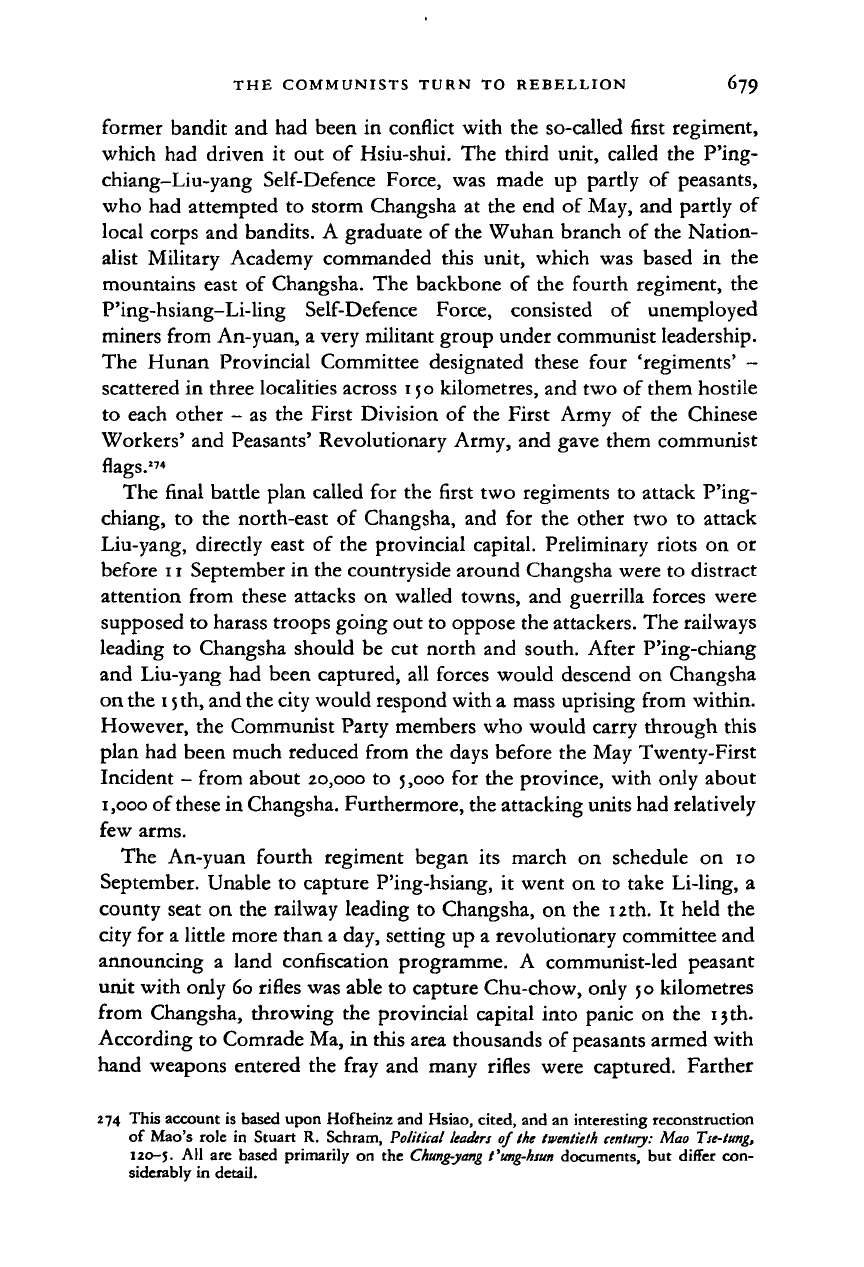
THE COMMUNISTS TURN TO REBELLION 679
former bandit and had been in conflict with the so-called first regiment,
which had driven it out of Hsiu-shui. The third unit, called the P'ing-
chiang-Liu-yang Self-Defence Force, was made up partly of peasants,
who had attempted to storm Changsha at the end of May, and partly of
local corps and bandits. A graduate of the Wuhan branch of the Nation-
alist Military Academy commanded this unit, which was based in the
mountains east of Changsha. The backbone of the fourth regiment, the
P'ing-hsiang-Li-ling Self-Defence Force, consisted of unemployed
miners from An-yuan, a very militant group under communist leadership.
The Hunan Provincial Committee designated these four 'regiments' -
scattered in three localities across 150 kilometres, and two of them hostile
to each other - as the First Division of the First Army of the Chinese
Workers' and Peasants' Revolutionary Army, and gave them communist
flags.'
74
The final battle plan called for the first two regiments to attack P'ing-
chiang, to the north-east of Changsha, and for the other two to attack
Liu-yang, directly east of the provincial capital. Preliminary riots on or
before 11 September in the countryside around Changsha were to distract
attention from these attacks on walled towns, and guerrilla forces were
supposed to harass troops going out to oppose the attackers. The railways
leading to Changsha should be cut north and south. After P'ing-chiang
and Liu-yang had been captured, all forces would descend on Changsha
on the 15 th, and the city would respond with a mass uprising from within.
However, the Communist Party members who would carry through this
plan had been much reduced from the days before the May Twenty-First
Incident - from about 20,000 to
5,000
for the province, with only about
1,000 of these in Changsha. Furthermore, the attacking units had relatively
few arms.
The An-yuan fourth regiment began its march on schedule on 10
September. Unable to capture P'ing-hsiang, it went on to take Li-ling, a
county seat on the railway leading to Changsha, on the 12th. It held the
city for a little more than a day, setting up a revolutionary committee and
announcing a land confiscation programme. A communist-led peasant
unit with only 60 rifles was able to capture Chu-chow, only 50 kilometres
from Changsha, throwing the provincial capital into panic on the 13 th.
According to Comrade Ma, in this area thousands of peasants armed with
hand weapons entered the fray and many rifles were captured. Farther
274 This account is based upon Hofheinz and Hsiao, cited, and an intetesting reconstruction
of Mao's role in Stuart R. Schram, Political
leaders
of
the twentieth
century:
Mao Tse-tung,
120-5.
All are based primarily on the
Chung-yang
t'mg-hsun documents, but differ con-
siderably in detail.
Cambridge Histories Online © Cambridge University Press, 2008
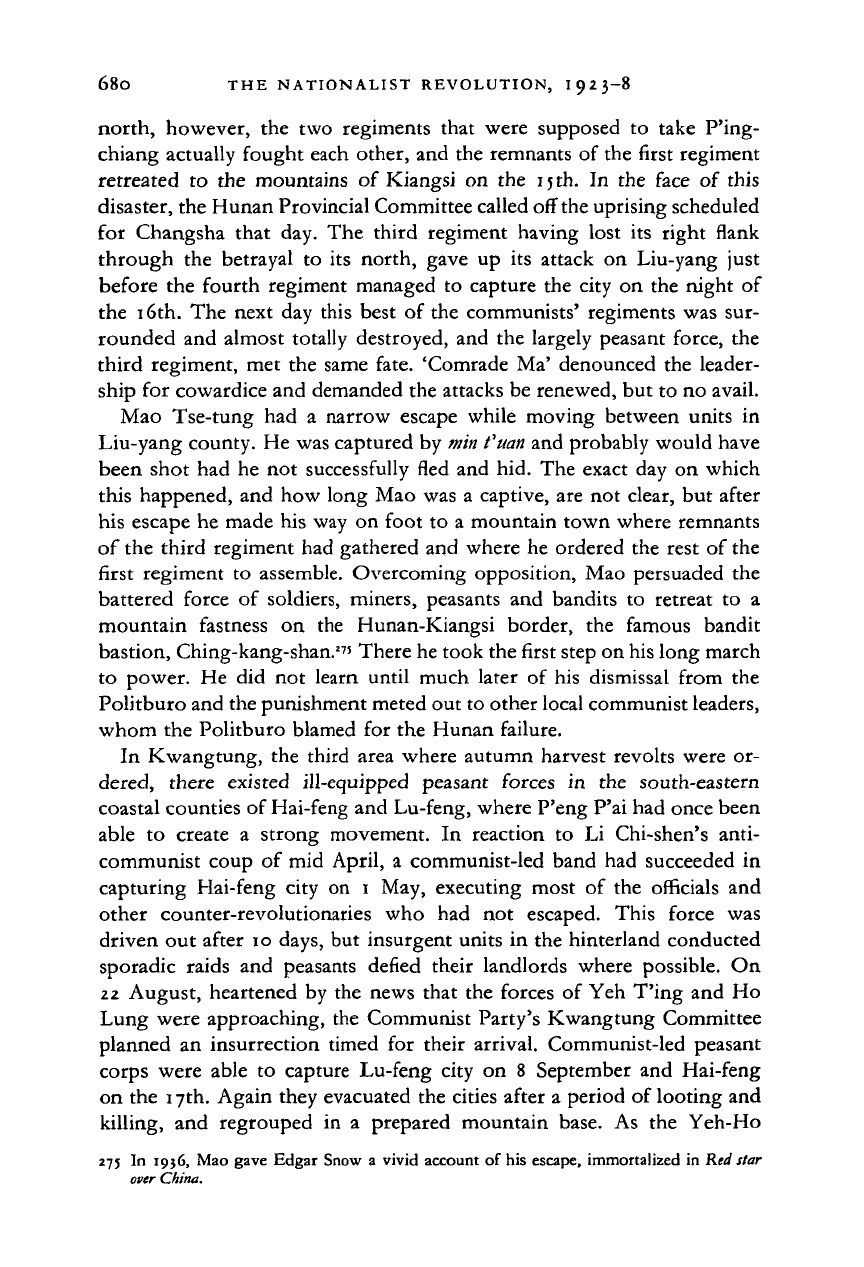
680 THE NATIONALIST REVOLUTION, I923-8
north, however,
the two
regiments that were supposed
to
take P'ing-
chiang actually fought each other,
and the
remnants
of
the first regiment
retreated
to the
mountains
of
Kiangsi
on the
15
th.
In the
face
of
this
disaster, the Hunan Provincial Committee called off the uprising scheduled
for Changsha that
day. The
third regiment having lost
its
right flank
through
the
betrayal
to its
north, gave
up its
attack
on
Liu-yang just
before
the
fourth regiment managed
to
capture
the
city
on the
night
of
the 16th.
The
next
day
this best
of
the communists' regiments was
sur-
rounded
and
almost totally destroyed,
and the
largely peasant force,
the
third regiment,
met the
same fate. 'Comrade
Ma'
denounced
the
leader-
ship
for
cowardice and demanded the attacks
be
renewed, but
to
no avail.
Mao Tse-tung
had a
narrow escape while moving between units
in
Liu-yang county.
He
was captured
by
min
fuan and probably would have
been shot
had he not
successfully fled
and
hid.
The
exact
day on
which
this happened,
and
how long Mao was
a
captive,
are not
clear,
but
after
his escape
he
made his way
on
foot
to a
mountain town where remnants
of the third regiment had gathered and where
he
ordered
the
rest
of
the
first regiment
to
assemble. Overcoming opposition, Mao persuaded
the
battered force
of
soldiers, miners, peasants
and
bandits
to
retreat
to a
mountain fastness
on the
Hunan-Kiangsi border,
the
famous bandit
bastion, Ching-kang-shan.
!7S
There he took the first step on his long march
to power.
He did not
learn until much later
of his
dismissal from
the
Politburo and the punishment meted out to other local communist leaders,
whom
the
Politburo blamed
for
the Hunan failure.
In Kwangtung,
the
third area where autumn harvest revolts were
or-
dered, there existed ill-equipped peasant forces
in the
south-eastern
coastal counties
of
Hai-feng and Lu-feng, where P'eng P'ai had once been
able
to
create
a
strong movement.
In
reaction
to Li
Chi-shen's anti-
communist coup
of
mid April,
a
communist-led band
had
succeeded
in
capturing Hai-feng city
on 1 May,
executing most
of the
officials
and
other counter-revolutionaries
who had not
escaped. This force
was
driven
out
after 10 days,
but
insurgent units
in
the hinterland conducted
sporadic raids
and
peasants defied their landlords where possible.
On
22 August, heartened
by the
news that
the
forces
of
Yeh T'ing
and Ho
Lung were approaching,
the
Communist Party's Kwangtung Committee
planned
an
insurrection timed
for
their arrival. Communist-led peasant
corps were able
to
capture Lu-feng city
on 8
September
and
Hai-feng
on
the
17th. Again they evacuated
the
cities after
a
period
of
looting and
killing,
and
regrouped
in a
prepared mountain base.
As the
Yeh-Ho
275
In
1936, Mao gave Edgar Snow
a
vivid account
of
his escape, immortalized
in
Red
star
over
China.
Cambridge Histories Online © Cambridge University Press, 2008
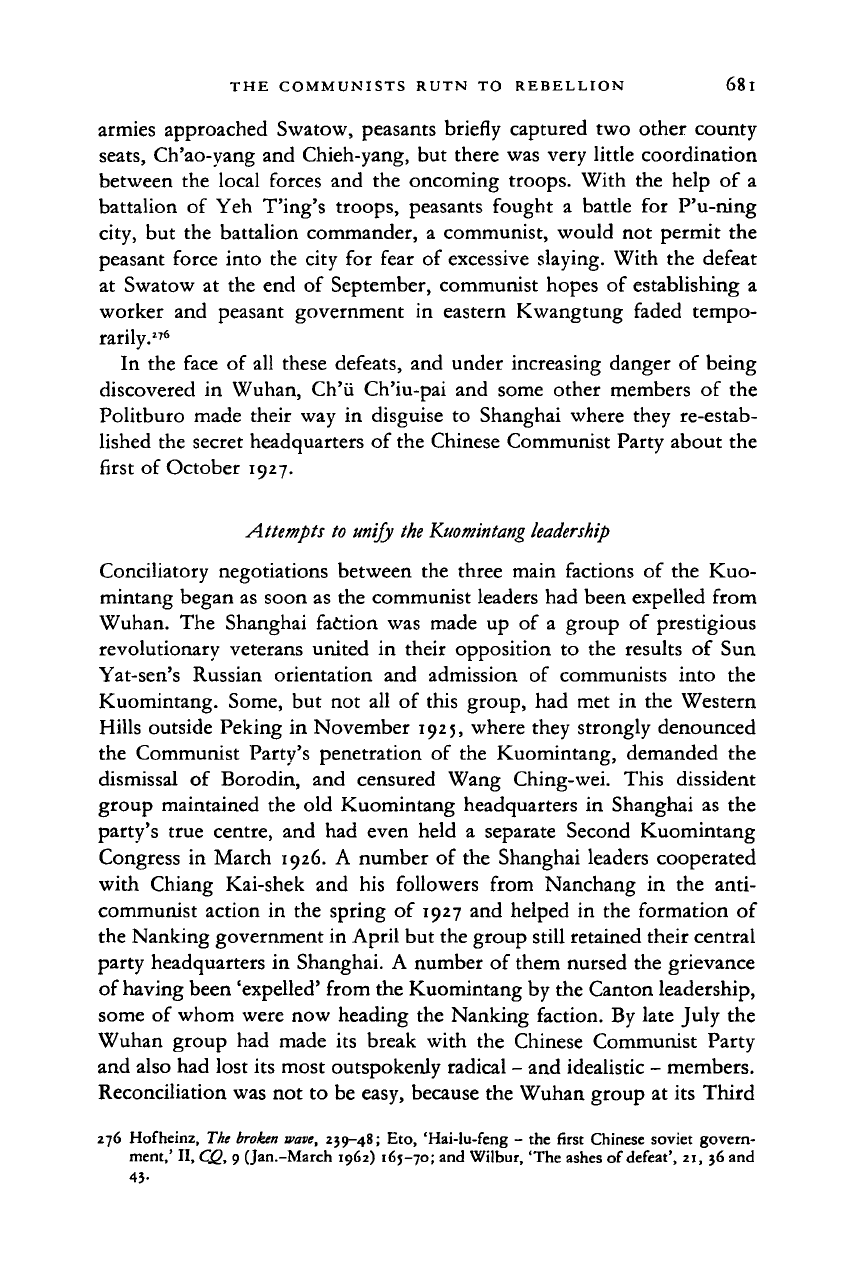
THE COMMUNISTS RUTN TO REBELLION 681
armies approached Swatow, peasants briefly captured two other county
seats,
Ch'ao-yang and Chieh-yang, but there was very little coordination
between the local forces and the oncoming troops. With the help of a
battalion of Yeh T'ing's troops, peasants fought a battle for P'u-ning
city, but the battalion commander, a communist, would not permit the
peasant force into the city for fear of excessive slaying. With the defeat
at Swatow at the end of September, communist hopes of establishing a
worker and peasant government in eastern Kwangtung faded tempo-
rarily.
276
In the face of all these defeats, and under increasing danger of being
discovered in Wuhan, Ch'ii Ch'iu-pai and some other members of the
Politburo made their way in disguise to Shanghai where they re-estab-
lished the secret headquarters of the Chinese Communist Party about the
first of October 1927.
Attempts to unify the Kuomintang
leadership
Conciliatory negotiations between the three main factions of the Kuo-
mintang began as soon as the communist leaders had been expelled from
Wuhan. The Shanghai faction was made up of a group of prestigious
revolutionary veterans united in their opposition to the results of Sun
Yat-sen's Russian orientation and admission of communists into the
Kuomintang. Some, but not all of this group, had met in the Western
Hills outside Peking in November 1925, where they strongly denounced
the Communist Party's penetration of the Kuomintang, demanded the
dismissal of Borodin, and censured Wang Ching-wei. This dissident
group maintained the old Kuomintang headquarters in Shanghai as the
party's true centre, and had even held a separate Second Kuomintang
Congress in March 1926. A number of the Shanghai leaders cooperated
with Chiang Kai-shek and his followers from Nanchang in the anti-
communist action in the spring of 1927 and helped in the formation of
the Nanking government in April but the group still retained their central
party headquarters in Shanghai. A number of them nursed the grievance
of having been 'expelled' from the Kuomintang by the Canton leadership,
some of whom were now heading the Nanking faction. By late July the
Wuhan group had made its break with the Chinese Communist Party
and also had lost its most outspokenly radical - and idealistic - members.
Reconciliation was not to be easy, because the Wuhan group at its Third
276 Hofheinz, The
broken
wave, 239-48; Eto, 'Hai-lu-feng - the first Chinese soviet govern-
ment,' II, CQ, 9 (Jan.-March 1962) 165-70; and Wilbur, 'The ashes of defeat', 21, 36 and
4}-
Cambridge Histories Online © Cambridge University Press, 2008
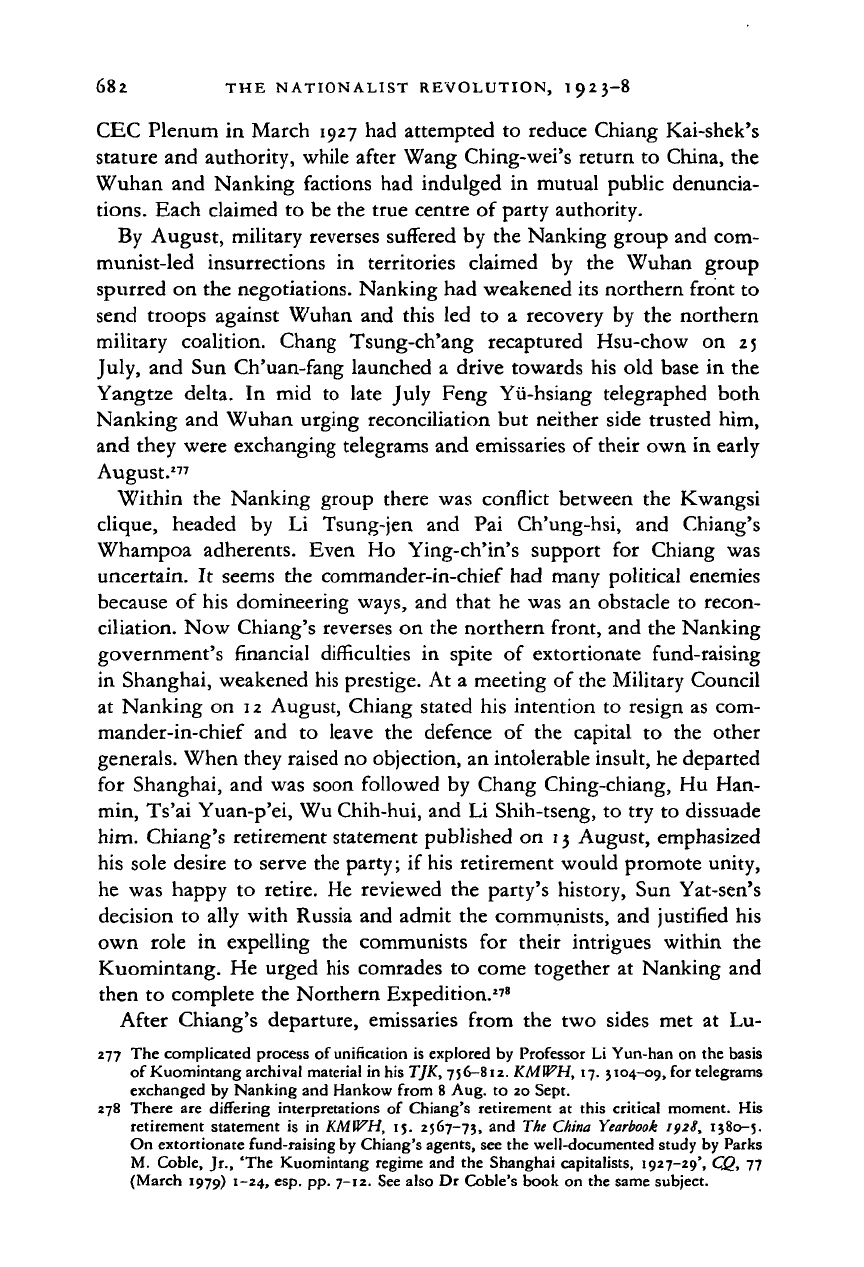
682 THE NATIONALIST REVOLUTION, 1923-8
CEC Plenum
in
March 1927 had attempted
to
reduce Chiang Kai-shek's
stature and authority, while after Wang Ching-wei's return to China, the
Wuhan and Nanking factions had indulged
in
mutual public denuncia-
tions.
Each claimed
to
be the true centre of party authority.
By August, military reverses suffered by the Nanking group and com-
munist-led insurrections
in
territories claimed
by the
Wuhan group
spurred on the negotiations. Nanking had weakened its northern front
to
send troops against Wuhan and this
led to a
recovery
by
the northern
military coalition. Chang Tsung-ch'ang recaptured Hsu-chow
on 25
July, and Sun Ch'uan-fang launched
a
drive towards his old base
in
the
Yangtze delta.
In mid to
late July Feng Yii-hsiang telegraphed both
Nanking and Wuhan urging reconciliation but neither side trusted him,
and they were exchanging telegrams and emissaries
of
their own in early
August.
277
Within
the
Nanking group there was conflict between
the
Kwangsi
clique, headed
by Li
Tsung-jen
and Pai
Ch'ung-hsi,
and
Chiang's
Whampoa adherents. Even
Ho
Ying-ch'in's support
for
Chiang
was
uncertain.
It
seems
the
commander-in-chief had many political enemies
because
of
his domineering ways, and that he was
an
obstacle
to
recon-
ciliation. Now Chiang's reverses on the northern front, and the Nanking
government's financial difficulties
in
spite
of
extortionate fund-raising
in Shanghai, weakened his prestige. At
a
meeting of the Military Council
at Nanking
on
12 August, Chiang stated his intention
to
resign as com-
mander-in-chief
and to
leave
the
defence
of the
capital
to the
other
generals. When they raised no objection, an intolerable insult, he departed
for Shanghai, and was soon followed
by
Chang Ching-chiang, Hu Han-
min, Ts'ai Yuan-p'ei, Wu Chih-hui, and Li Shih-tseng,
to
try
to
dissuade
him. Chiang's retirement statement published on 13 August, emphasized
his sole desire
to
serve the party;
if
his retirement would promote unity,
he was happy
to
retire. He reviewed
the
party's history, Sun Yat-sen's
decision
to
ally with Russia and admit the communists, and justified his
own role
in
expelling
the
communists
for
their intrigues within
the
Kuomintang.
He
urged his comrades
to
come together
at
Nanking and
then
to
complete the Northern Expedition.
2
'
8
After Chiang's departure, emissaries from
the two
sides met
at Lu-
277 The complicated process
of
unification
is
explored by Professor
Li
Yun-han on the basis
of Kuomintang archival material in his TJK, 756-812. KM1PH, 17. 3104-09, for telegrams
exchanged by Nanking and Hankow from
8
Aug.
to
20 Sept.
278 There
are
differing interpretations
of
Chiang's retirement
at
this critical moment.
His
retirement statement
is in
KNIWH,
15.
2567-75, and The China Yearbook 1928, 1580-5.
On extortionate fund-raising by Chiang's agents, see the well-documented study by Parks
M. Coble, Jr., 'The Kuomintang regime and the Shanghai capitalists, 1927-29', CQ,
77
(March 1979)
I-2
4>
es
P' PP- 7~
12
- See also Dr Coble's book on the same subject.
Cambridge Histories Online © Cambridge University Press, 2008
